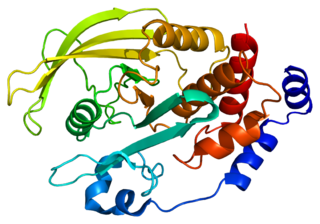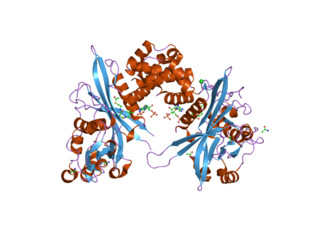Related Research Articles

Caspases are a family of protease enzymes playing essential roles in programmed cell death. They are named caspases due to their specific cysteine protease activity – a cysteine in its active site nucleophilically attacks and cleaves a target protein only after an aspartic acid residue. As of 2009, there are 12 confirmed caspases in humans and 10 in mice, carrying out a variety of cellular functions.

Histone methyltransferases (HMT) are histone-modifying enzymes, that catalyze the transfer of one, two, or three methyl groups to lysine and arginine residues of histone proteins. The attachment of methyl groups occurs predominantly at specific lysine or arginine residues on histones H3 and H4. Two major types of histone methyltranferases exist, lysine-specific and arginine-specific. In both types of histone methyltransferases, S-Adenosyl methionine (SAM) serves as a cofactor and methyl donor group.
The genomic DNA of eukaryotes associates with histones to form chromatin. The level of chromatin compaction depends heavily on histone methylation and other post-translational modifications of histones. Histone methylation is a principal epigenetic modification of chromatin that determines gene expression, genomic stability, stem cell maturation, cell lineage development, genetic imprinting, DNA methylation, and cell mitosis.

A catalytic triad is a set of three coordinated amino acids that can be found in the active site of some enzymes. Catalytic triads are most commonly found in hydrolase and transferase enzymes. An acid-base-nucleophile triad is a common motif for generating a nucleophilic residue for covalent catalysis. The residues form a charge-relay network to polarise and activate the nucleophile, which attacks the substrate, forming a covalent intermediate which is then hydrolysed to release the product and regenerate free enzyme. The nucleophile is most commonly a serine or cysteine amino acid, but occasionally threonine or even selenocysteine. The 3D structure of the enzyme brings together the triad residues in a precise orientation, even though they may be far apart in the sequence.

Granzyme A is an enzyme. that in humans is encoded by the GZMA gene, and is one of the five granzymes encoded in the human genome. This enzyme is present in cytotoxic T lymphocyte granules.
p14ARF is an alternate reading frame protein product of the CDKN2A locus. p14ARF is induced in response to elevated mitogenic stimulation, such as aberrant growth signaling from MYC and Ras (protein). It accumulates mainly in the nucleolus where it forms stable complexes with NPM or Mdm2. These interactions allow p14ARF to act as a tumor suppressor by inhibiting ribosome biogenesis or initiating p53-dependent cell cycle arrest and apoptosis, respectively. p14ARF is an atypical protein, in terms of its transcription, its amino acid composition, and its degradation: it is transcribed in an alternate reading frame of a different protein, it is highly basic, and it is polyubiquinated at the N-terminus.
Paracaspases are members of the C14 family of cysteine proteases. Paracaspases are proteins related to caspases present in animals and slime mold, in contrast to metacaspases, which are present in plants, fungi, and "protists". The phylogenetic distribution is a bit confusing, since slime mold diverged earlier than the animal/fungal split.

Caspase-3 is a caspase protein that interacts with caspase-8 and caspase-9. It is encoded by the CASP3 gene. CASP3 orthologs have been identified in numerous mammals for which complete genome data are available. Unique orthologs are also present in birds, lizards, lissamphibians, and teleosts.

Caspase-6 is an enzyme that in humans is encoded by the CASP6 gene. CASP6 orthologs have been identified in numerous mammals for which complete genome data are available. Unique orthologs are also present in birds, lizards, lissamphibians, and teleosts. Caspase-6 has known functions in apoptosis, early immune response and neurodegeneration in Huntington's and Alzheimer's disease.

Caspase-10 is an enzyme that, in humans, is encoded by the CASP10 gene.
Lipoyl synthase is an enzyme that belongs to the radical SAM (S-adenosylmethionine) family. Within the radical SAM superfamily, lipoyl synthase is in a sub-family of enzymes that catalyze sulfur insertion reactions. Enzymes in this family contain two 4Fe-4S clusters, from which they obtain the sulfur groups that will be transferred onto the corresponding substrates. This particular enzyme participates in lipoic acid metabolism, so it transfers two sulfurs from its 4Fe-4S cluster onto the protein N6-(octanoyl)lysine through radical generation. This enzyme is usually localized to the mitochondria. Two organisms that have been extensively studied with regards to this enzyme are Escherichia coli andMycobacterium tuberculosis. It is also found in other organisms, such as yeast and plants.

B-cell lymphoma/leukemia 10 is a protein that in humans is encoded by the BCL10 gene. Like BCL2, BCL3, BCL5, BCL6, BCL7A, and BCL9, it has clinical significance in lymphoma.

Tyrosine-protein phosphatase non-receptor type 2 is an enzyme that in humans is encoded by the PTPN2 gene.

PITSLRE serine/threonine-protein kinase CDC2L1 is an enzyme that in humans is encoded by the CDC2L1 gene.

Ubiquitin thioesterase OTUB1 also known as otubain-1 is an enzyme that in humans is encoded by the OTUB1 gene. Alternative splicing results in multiple transcript variants.

Histone acetyltransferase 1, also known as HAT1, is an enzyme that, in humans, is encoded by the HAT1 gene.
The N-end rule is a rule that governs the rate of protein degradation through recognition of the N-terminal residue of proteins. The rule states that the N-terminal amino acid of a protein determines its half-life. The rule applies to both eukaryotic and prokaryotic organisms, but with different strength, rules, and outcome. In eukaryotic cells, these N-terminal residues are recognized and targeted by ubiquitin ligases, mediating ubiquitination thereby marking the protein for degradation. The rule was initially discovered by Alexander Varshavsky and co-workers in 1986. However, only rough estimations of protein half-life can be deduced from this 'rule', as N-terminal amino acid modification can lead to variability and anomalies, whilst amino acid impact can also change from organism to organism. Other degradation signals, known as degrons, can also be found in sequence.

The WRKY domain is found in the WRKY transcription factor family, a class of transcription factors. The WRKY domain is found almost exclusively in plants although WRKY genes appear present in some diplomonads, social amoebae and other amoebozoa, and fungi incertae sedis. They appear absent in other non-plant species. WRKY transcription factors have been a significant area of plant research for the past 20 years. The WRKY DNA-binding domain recognizes the W-box (T)TGAC(C/T) cis-regulatory element.
Signal peptidase I is an enzyme. This enzyme catalyses the following chemical reaction

Rhomboid-related protein 2 is a protein that in humans is encoded by the RHBDL2 gene.

Philip A. Rea is a British biochemist, science writer and educator, who is currently Professor of Biology and Rebecka and Arie Belldegrun Distinguished Director of the Vagelos Program in Life Sciences & Management at the University of Pennsylvania. His major contributions as a biochemist have been in the areas of membrane transport and xenobiotic detoxification, and as a science writer and educator in understanding the intersection between the life sciences and their implementation. In 2005, he and Mark V. Pauly founded the Roy and Diana Vagelos Program in Life Sciences & Management between the School of Arts and Sciences and Wharton School at the University of Pennsylvania, which he continues to co-direct in his capacity as Belldegrun Distinguished Director. Rea's work on serendipity in science has been featured in The Wall Street Journal. Additionally, he has served as a subject matter expert for 'The Scientist.
References
- ↑ Uren AG, O'Rourke K, Aravind LA, et al. (Oct 2000). "Identification of paracaspases and metacaspases: two ancient families of caspase-like proteins, one of which plays a key role in MALT lymphoma". Molecular Cell. 6 (4): 961–7. doi: 10.1016/S1097-2765(05)00086-9 . PMID 11090634.
- ↑ Vercammen D, van de Cotte B, De Jaeger G, et al. (Oct 2004). "Type II metacaspases Atmc4 and Atmc9 of Arabidopsis thaliana cleave substrates after arginine and lysine". J Biol Chem. 279 (44): 45329–36. doi: 10.1074/jbc.M406329200 . PMID 15326173.
- ↑ Asplund-Samuelsson J, Bergman B, Larsson J (Nov 2012). "Prokaryotic caspase homologs: phylogenetic patterns and functional characteristics reveal considerable diversity". PLOS ONE. 7 (11): e49888. Bibcode:2012PLoSO...749888A. doi: 10.1371/journal.pone.0049888 . PMC 3501461 . PMID 23185476.
- ↑ Wilson W, et al. (2017). "Genomic exploration of individual giant ocean viruses". The ISME Journal. 11 (8): 1736–1745. doi:10.1038/ismej.2017.61. PMC 5520044 . PMID 28498373.
- ↑ Vercammen D, van de Cotte B, De Jaeger G, et al. (Oct 2004). "Type II metacaspases Atmc4 and Atmc9 of Arabidopsis thaliana cleave substrates after arginine and lysine". J Biol Chem. 279 (44): 45329–36. doi: 10.1074/jbc.M406329200 . PMID 15326173.
- ↑ Nedelcu AM, Miles IH, Fagir AM, Karol K (Aug 2008). "Adaptive eukaryote-to-eukaryote lateral gene transfer: stress-related genes of algal origin in the closest unicellular relatives of animals". J Evol Biol. 21 (6): 1852–60. doi: 10.1111/j.1420-9101.2008.01605.x . PMID 18717747.
- ↑ Madeo F, Herker E, Maldener C, et al. (Apr 2002). "A caspase-related protease regulates apoptosis in yeast". Molecular Cell. 9 (4): 911–7. doi: 10.1016/S1097-2765(02)00501-4 . PMID 11983181.
- ↑ Bozhkov PV, Suarez MF, Filonova LH, et al. (Oct 2005). "Cysteine protease mcII-Pa executes programmed cell death during plant embryogenesis". Proc Natl Acad Sci U S A. 102 (40): 14463–8. Bibcode:2005PNAS..10214463B. doi: 10.1073/pnas.0506948102 . PMC 1242326 . PMID 16183741.
- ↑ Khan MA, Chock PB, Stadtman ER (Nov 2005). "Knockout of caspase-like gene, YCA1, abrogates apoptosis and elevates oxidized proteins in Saccharomyces cerevisiae". Proc Natl Acad Sci U S A. 102 (48): 17326–31. Bibcode:2005PNAS..10217326K. doi: 10.1073/pnas.0508120102 . PMC 1287485 . PMID 16301538.